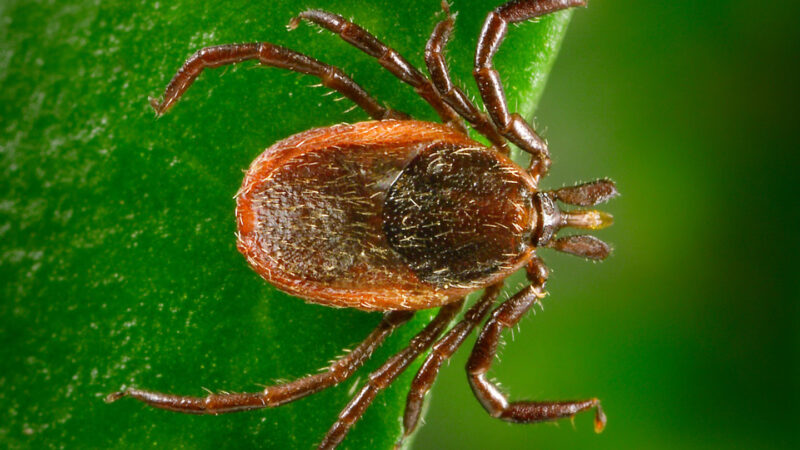In June 2017, Cathy Raley was about to take her dog on a hike when she suddenly broke out in hives. Her tongue swelled and her throat got tight. “That’s when I called 911,” she recalls.
On the way to the hospital, Raley stopped being able to swallow. She was immediately given a steroid. She also received a medicine for severe allergic reactions called epinephrine (Ep-ih-NEFF-rin). That eventually calmed her symptoms, though Raley had to spend four hours in the hospital before she could go home.
She’d clearly suffered a major allergic reaction — but to what? She was 61 years old and didn’t know of anything she was allergic to. So she went to an allergist who combed through her history for clues to what happened.
One hint: Raley had recently had another bout of hives. That one erupted in the middle of the night — a sign that it had been a delayed reaction to something. And both times, the hives had occurred after she’d cooked red meat: beef and pork.
“I have no idea if it’s related,” Raley finally told the allergist, but “two months ago, I got bitten by a tick.”
That turned out to be the key to solving Raley’s mystery.

She was later diagnosed with alpha-gal syndrome. This is an allergy to red meat that scientists knew could develop in response to the bite of a lone star tick. Raley, however, had been bitten while hiking near her home in Olympia, Wash. Lone star ticks are found only east of the Rocky Mountains — thousands of kilometers (miles) away.
Two new research reports — one on Raley’s case and another on a woman in Maine — now suggest the lone star tick isn’t the only U.S. tick that can trigger this allergy. The western blacklegged tick and the deer tick may trigger an allergy to red meat, too.
“It was a very surprising finding,” says Hanna Oltean. She works at Washington State’s Department of Health in Shoreline. As an epidemiologist, she studies the spread and control of diseases. Oltean was part of a team that described the two alpha-gal cases in Emerging Infectious Diseases in April.
This report raises new questions about a little-known — and potentially deadly — allergy.
How alpha-gal syndrome works
Scientists discovered alpha-gal syndrome in 2009.
It was first reported in 24 people who’d had allergic reactions a few hours after eating red meat, such as beef, pork or lamb. More than eight in every 10 of them recalled being bitten by ticks before showing these symptoms. That raised scientists’ suspicions that tick bites may have triggered the allergies.
The saliva of certain tick species carries a sugar molecule called alpha-gal. These species include the lone star tick and others found in Europe and Australia. When these ticks bite, the sugar molecule and other compounds can get into someone’s body. There, they can somehow make the immune systems go haywire.
The next exposure to alpha-gal may trigger an allergic reaction in these people. Red meats and other animal products (such as milk and gelatin) are rich in alpha-gal. So those foods could incite that bad reaction.

“Alpha-gal syndrome can present very differently from patient to patient,” says Johanna Salzer. This epidemiologist works at the U.S. Centers for Disease Control and Prevention in Atlanta, Ga.
Some people may get hives and throat swelling, as Raley did. Other cases may look more like the woman from Maine. She’d been bitten by a deer tick. Later, after eating red meat, she developed abdominal pain, diarrhea and vomiting.
The delayed and often mysterious nature of a patient’s stomach issues can make alpha-gal syndrome hard to diagnose, says Sarah McGill. As a gastroenterologist, she specializes in the digestive system. She works at the University of North Carolina School of Medicine in Chapel Hill.
In the past, doctors hadn’t considered food allergies when seeing adult patients with chronic digestive problems, she says. Why? Most food allergies develop when people are young. “But alpha-gal syndrome is very unique,” she says. “Adults can get it suddenly.” And there’s no cure — though some people may eventually be able to eat red meat again without issue.
Alpha-gal syndrome is not well-known
Another problem: Many doctors and nurses have never heard of alpha-gal syndrome.
In one U.S. survey of healthcare providers, more than four in every 10 had not heard of the condition. Among those who had, about one in three didn’t know how it was acquired. Nearly half didn’t know what tests to order to diagnose it. Salzer and her colleagues shared these results in 2023.
McGill has seen patients whose alpha-gal symptoms were dismissed by other doctors. When patients asked to be tested for the condition, some doctors had refused.
Those experiences remind McGill of celiac disease, another digestive illness. Here, the immune system overreacts to gluten. This disease was misunderstood for a long time. Patients were sometimes told their symptoms were in their head, McGill says. “I see that same pattern happening with alpha-gal syndrome.”
Increasing awareness among doctors and nurses could speed up diagnosis, Salzer says. That in turn could help patients feel better faster.
It’s hard to know just how many patients we’re talking about. While alpha-gal syndrome appears fairly rare, exact numbers are hard to pin down. Salzer was part of a team that tallied about 110,000 suspected cases in the United States from 2010 to 2022. But this might be an undercount. As many as 450,000 people might have been affected during this time, those researchers say.
How to avoid alpha-gal syndrome
And this condition can be life-threatening, Oltean emphasizes. But if people know the risks, she adds, “they can take appropriate precautions.”
For Oltean, that means avoiding tick bites. She knows that can be difficult, especially during tick season. Ticks are generally seeking blood meals from early spring to late fall, depending on where you live.
After being outdoors, many people scan their bodies to ensure they’re not carrying any ticks. Quickly finding and removing those tiny arachnids can keep them from spreading diseases. That’s the case for Lyme disease and Rocky Mountain spotted fever. A tick must latch onto someone’s body for hours or days to transmit the bacteria that cause those illnesses.
“That does not seem to be the case with alpha-gal syndrome,” Oltean says. There are no bacteria being transmitted. Tick saliva is thought to cause the allergy. So it’s possible that a single bite from a tick — even one yanked away at once — could spark the condition.
Oltean is brimming with tips to prevent tick bites. Walk in the center of trails. Avoid tall brush and grassy areas. Wear tightly woven clothing. Apply tick repellent to exposed skin, and shower soon after being outdoors.
Since alpha-gal syndrome was discovered so recently, there’s still a lot to learn about who’s most at risk.
“Why are some people bitten by ticks all the time and they never develop alpha-gal syndrome?” Salzer asks. She also wants to know just how long a tick must attach for someone to get the condition.
Her research suggests that most U.S. alpha-gal cases have happened in the lone star ticks’ range. Oltean wonders why lone star ticks seem better at triggering an immune response. And do multiple tick bites over time make someone more likely to develop the condition?
Answering such questions could help people protect themselves from this condition — and help doctors better spot those who have it.


















